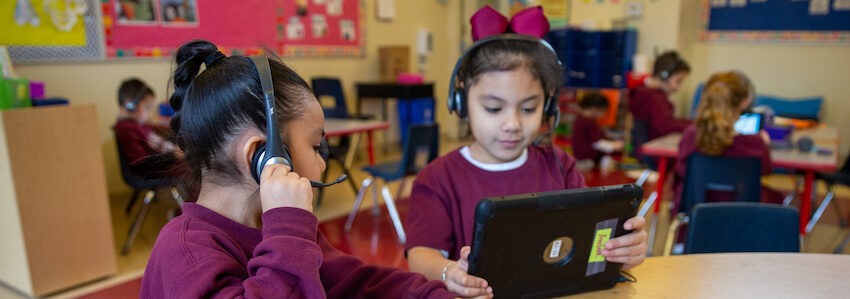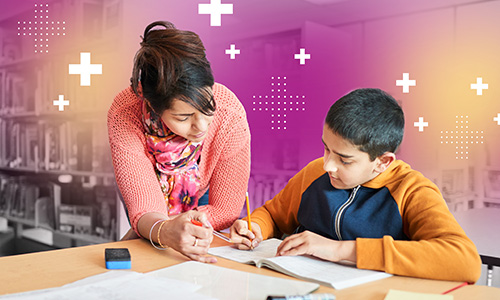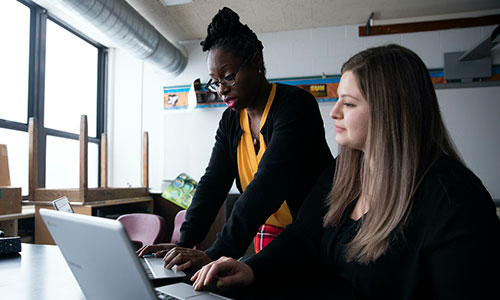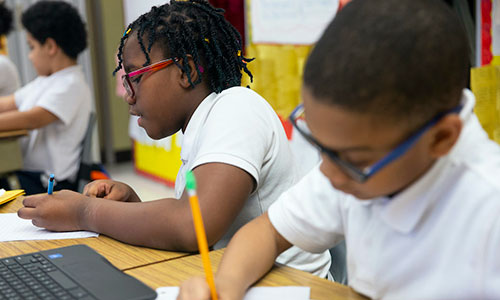
When it comes to technology, some of us are gadget-loving early adopters and some of us are Luddites who think it’s all been downhill since the advent of the printing press. Most of us are probably somewhere in the middle, but the one thing we can all agree on is that we’ll continue to see the emergence of new technologies in just about every aspect of our daily lives, and that includes technology in the classroom.
Melissa Lim, a technology integration specialist for Portland Public Schools in Oregon, who also has many years of experience as a classroom teacher, counts herself among those who see technology as something not to be feared, but embraced—and maybe even enjoyed. On a recent episode of The Continuing Educator podcast titled “Push that button!” Melissa chatted about all things tech with cohosts Jacob Bruno, executive vice president of Learning & Improvement Services at NWEA, and middle school math teacher Kailey Rhodes.
Read on to get Melissa’s thoughts on how ChatGPT can be used for good, the importance of bridging the digital divide in the classroom, and the number-one thing teachers should remember when they’re experimenting with new technology in the classroom (hint: it’s in the episode title).
Resistance to tech: The first hurdle
Before we get into the technological weeds, it’s important to name that resistance to technology is—and always has been—a natural human reaction to rapid change. As Jacob recalls from his own days in school, the fear of calculator usage was once very real among educators who worried that it would stunt the skills of budding mathematicians. And today, of course, ChatGPT and other artificial intelligence tools have the education field worried about cheating.
In addition, it’s understandable that many of us associate technology in education with the pandemic, a time when we had no choice but to use relatively new digital tools to ensure a semblance of continuity for students. “There are a lot of teachers who don’t want to use technology at all because we were online so much during the pandemic, and that was a really rough time,” says Melissa.
So, how do we move past the feelings of stress and fatigue that often come with introductions of new technology? For Melissa, the answer is clear: use technology when it makes sense to do so, and never for its own sake.
“If you would rather do a paper-and-pencil activity or an analog activity, that’s great,” she says. “But if you want to take a risk and try [a new tool] with your students, and you have people [who] can support you, go for it.”
5 tips to keep in mind
In their half-hour conversation, Melissa, Jacob, and Kailey were able to just skim the surface of today’s classroom technology landscape. But their chat produced a number of concrete takeaways that teachers can start putting to use right away.
1. Don’t be afraid to push buttons!
With this advice, Melissa doesn’t mean getting under someone’s skin. It’s a bit more literal than that. “I think a lot of people are afraid that they’ll break something if they push a specific button, whether it’s on a screen or on a device,” she says of technology in the classroom. Instead of approaching tech from a place of fear, teachers should follow their students’ lead and be willing to take risks. “That’s how kids learn,” she points out. “Kids are constantly just pushing buttons and trying stuff out. […] They’re not afraid to try things.”
2. Ask for help
In days gone by, teachers typically had all the knowledge they needed to run their own classrooms effectively. Today, we’re living in a more complex world where expertise is more distributed. Teachers should feel just fine about having to call for help when needed. As Kailey points out, teachers don’t have to be technology specialists, but it helps to know some!
3. Find that balance between fun and challenging
“To me, learning has to be fun…[and] there also has to be struggle,” Melissa says. “I find that if there’s a struggle, that’s when I learn the most. But when I do workshops and professional learning, I always ask myself: Would I have fun doing this if I was a participant?”
With this teacher-centric view of fun in mind, Melissa recommends a handful of popular tools that teachers are using today to help keep themselves and their students challenged, organized, and inspired:
- Mmhmm A platform for increasing attention, engagement, and fun in online meetings.
- Canvas A learning management system with the stated goal of “amplifying everyone’s awesomeness.”
- Seesaw A platform for student engagement aimed at teachers, students, and families.
- BrainPOP A site for games, movies, animations, quizzes, activities, and more.
- Nearpod A Google-integrated platform offering real-time insights into student learning.
4. When it comes to AI, keep an open mind
Given what Jacob aptly calls the recent “explosion” of ChatGPT and other artificial intelligence tools, we have no choice but to reckon with the inevitable impacts of these tools in the classroom. And when it comes to weighing the benefits and harms of these technologies—a consideration as old as technology itself—Melissa and Kailey are optimistic. Teachers are successfully using AI to create and improve quizzes, Melissa points out, and some teachers are even demystifying ChatGPT in their classrooms by showing their kids how it works.
And when Kailey was building an activity for her students on Pi Day, she realized ChatGPT could help. “I said, ‘Can you generate for me a list of round things with different circumferences and diameters?’ And it did. And then I used those for my activity. It was so helpful.”
Melissa adds that while AI will never replace teachers, it can certainly save them some much-needed time. “You can input something and you get a skeleton of information,” she says. “And then that’s where […] you take that skeleton, flesh it out, [and] put more of your perspective into it.”
5. Bridge the digital divide
Though teachers can be technophiles, technophobes, or something in between, their students all deserve the same access to technology. Melissa reminds teachers that it’s up to them to provide these equitable learning experiences, regardless of their own preferences. “You might have one teacher [who’s] really good at using technology and is always providing some kind of experience that uses technology […] but then you have some teachers [who] are still maybe not comfortable […] and so they’re really doing a disservice to their students in not providing those kinds of experiences.”
Again, teachers don’t have to figure it all out themselves. That’s why we have technology integration specialists like Melissa who are passionate about helping teachers bridge the digital divide that, all too often, separates kids into the haves and have-nots. Technology in the classroom should be available to all kids.
Remember: Technology does not equal aptitude
Kailey, who has attended several trainings led by Melissa, notes that even Melissa can get tripped up by technology sometimes, but she takes it in stride. “Technology doesn’t always cooperate,” she says. “I notice a lot of teachers who, when their technology is misbehaving, they get a little defensive about it. Almost like it’s their child and their child is embarrassing them.” But with a bit of humility and a sense of humor, we can all get away from the idea that our skill level with technology represents our general aptitude.
Hear more
Want to learn more about technology in the classroom from Melissa and see what she’s up to? Follow her on X/Twitter at @ActionHero. And to hear the whole conversation about technology in the classroom that inspired this post, listen to the podcast episode.







